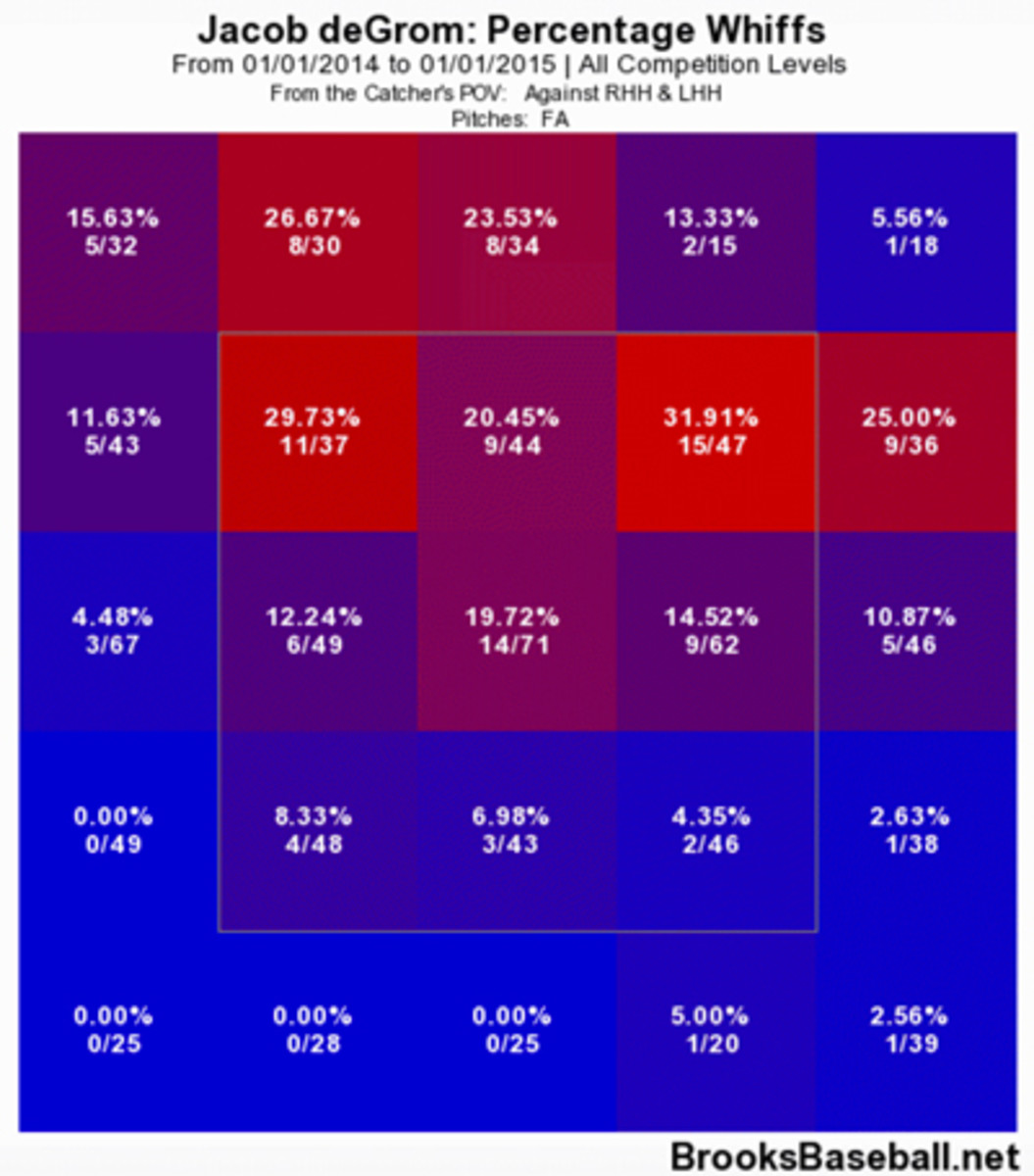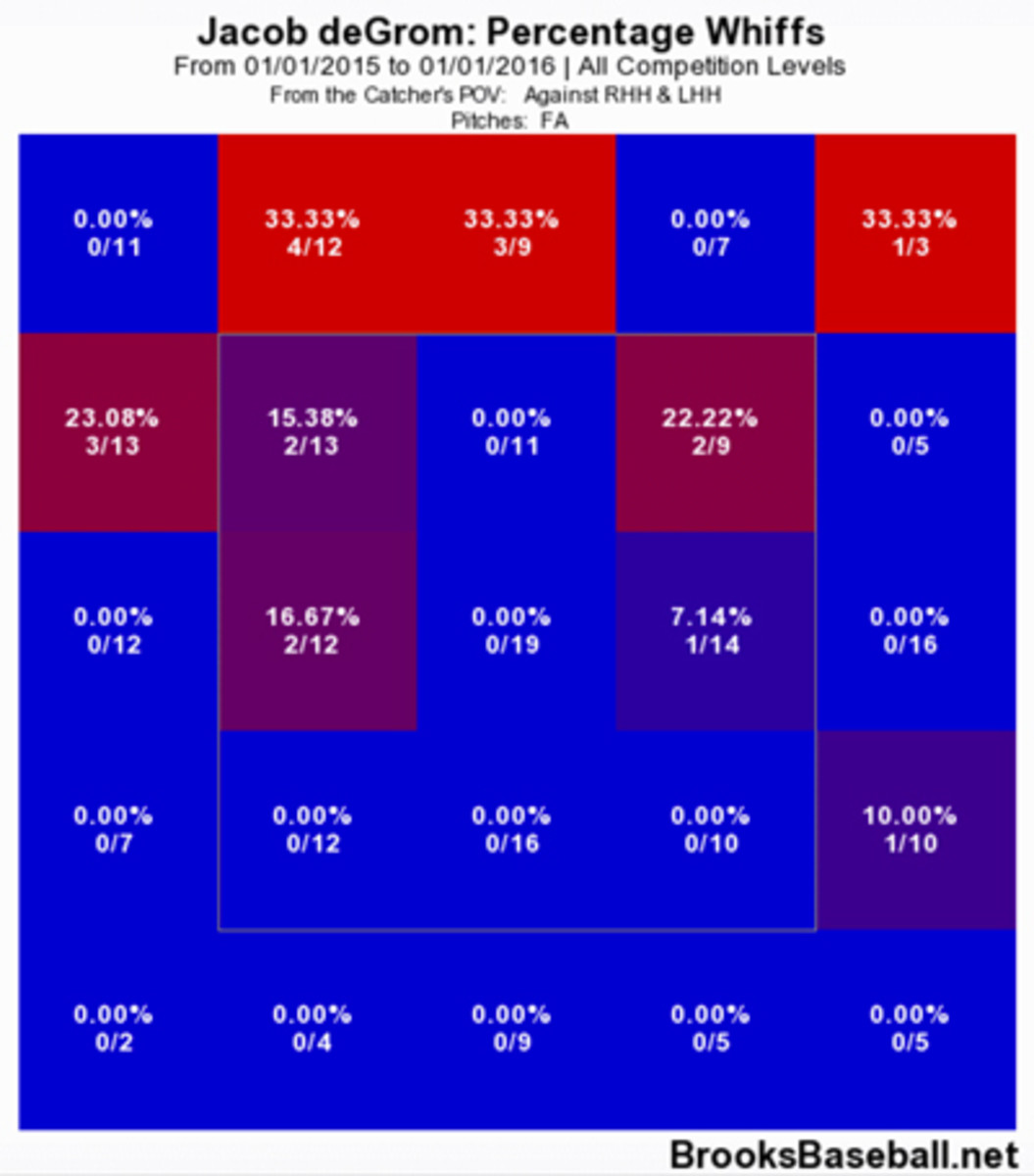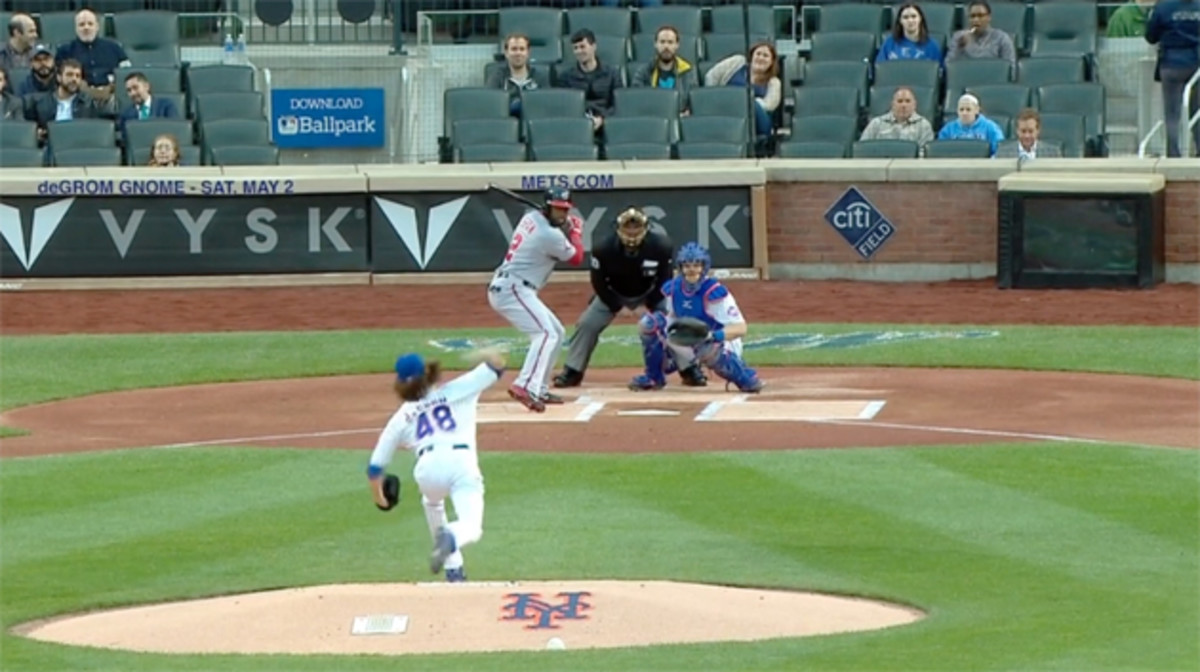Pitcher scouting: Is Jacob deGrom becoming too predictable?

It’s the first week of May, and the Mets are in first place in the NL East. All you have to do is consult the standings at this time last year (Brewers with a five-game lead in the NL Central, finish eight games back), or the year before (Giants leading the NL West, finish 10 games under .500), or even the year before that (Rays with the best record in baseball, end up missing the playoffs) to understand that these things don’t always last. However, it's been a while since the Mets and their fans have been able to get excited about baseball, so we shouldn’t take this away from them.
Pitching Report: Sonny Gray, David Price continue to intimidate foes
This era of good feelings, however, has obscured a fact that should be troubling Mets fans, as well as some fantasy owners. Through five starts, Jacob deGrom is not matching the level he pitched at when he won the NL Rookie of the Year in 2014. There’s a lot of baseball to be played between now and the end of the season, but if deGrom doesn’t pitch like a frontline starter, the Mets won’t be on top of the division for long, and his fantasy owners will take a loss on their investment. The question, then, goes thusly: Where is deGrom falling short this year, and is there reason to panic?
Before we get to the why, let’s first identify the what. Last season, deGrom had a 25.5% strikeout rate and fanned more than a batter per inning. This season, he’s short of 7 K/9, and his strikeout rate is down to 18.3%. His swinging-strike rate has fallen by 2.5 percentage points, which means hitters are coming up empty 20% less often than they did last year. His contact rate on pitches in and out of the zone have both increased. All of this screams that deGrom has been far more hittable this season.
• CORCORAN: Red Sox's optimism running low with struggling rotation
DeGrom’s velocity is fine this season—his four-seam fastball and sinker are both still registering right at 95 mph. (In fact, they’re up a few tenths from last season.) What’s not fine is his movement. The following two tables from Brooks Baseball the horizontal and vertical movement in inches, respectively, for each of the five pitches in deGrom’s repertoire.
<p>Year</p> | <p>Fourseam</p> | <p>Sinker</p> | <p>Change</p> | <p>Slider</p> | <p>Curve</p> |
|---|---|---|---|---|---|
2014 | -3.73 | -7.57 | -6.62 | 1.52 | 4.48 |
2015 | -4.99 | -8.44 | 7.35 | 0.32 | 3.50 |
<p>Year</p> | <p>Fourseam</p> | <p>Sinker</p> | <p>Change</p> | <p>Slider</p> | <p>Curve</p> |
|---|---|---|---|---|---|
2014 | 9.28 | 6.79 | 3.84 | 3.35 | -1.82 |
2015 | 9.22 | 7.17 | 4.04 | 4.77 | -1.02 |
The discrepancies of note are deGrom’s slider and curve horizontal movement, and sinker, changeup and curve vertical movement. Each of those has trended in the wrong direction this season, with predictable results. The whiff rate on his changeup has fallen nearly two percentage points. He throws his curveball just 7% of the time, but its whiff rate has slipped all the way to 5.1% from 17.7%. Hitters have a .393 batting average and .536 slugging percentage against his sinker, a pitch he throws nearly one-fifth of the time.
And then there’s the fastball. Hitters have just a .189 batting average against deGrom’s four-seamer, but they’re slugging .396 when they put it in play, up from .294 last year. What’s especially troubling is they’re putting it in play at an alarming rate. Last season, deGrom got whiffs on 12.3 percent of his fastballs. That’s down to 7.7 percent this year. What’s more, deGrom is losing all of that ground on pitches in the zone. The following charts show deGrom’s whiff rates for each of the 25 zones defined by Brooks Baseball, with the nine in the middle comprising the strike zone. The first is from 2014, and the second is from this season.


The differences here are stark. On balance, deGrom is inducing about the same number of swings on fastballs up in the zone this season as he did a year ago. However, he’s not blowing the pitch past hitters anymore, despite slightly increased velocity. Hitters whiffed on 27.3% of deGrom’s fastballs in the upper-third of the zone last year. If you limit the sample to pitches they offered at, the rate jumps to 33.7%. This year, those rates have decreased to 12.1% and 18.1%, respectively.
Fantasy baseball waiver wire: Quality outfielders worth picking up
There are four potential factors at play here. First, the four-seamer could be fundamentally different from the pitch it was last year. Second, hitters may have simply adjusted to the offering. The third possibility is that the relative success hitters are having this year is situational, with deGrom throwing the pitch in negative counts. Finally, it could be nothing more than a statistical anomaly.
Mechanically, deGrom looks the same from year to year when throwing the fastball. The first GIF below is from a start against the Braves last July. The second is from his first start this season, and the third is from a late April outing against the Nationals. Everything from the moment he begins his windup until he finishes his follow through is identical.
Moreover, here’s what he looks like at the release point. His arm angle is the same, as is the positioning of his glove hand, plant leg, and landing leg.



This isn’t exactly a clearinghouse of deGrom four-seamers, but it’s sufficient for our purposes here. Mechanics is not the root problem, and that’s a good thing.
Hitter adjustments almost certainly are part of the equation, especially by lefties. Last season, deGrom held left-handed hitters to a .224/.303/.336 slash line. This season, they’re lighting him up to the tune of a .373/.413/.552 triple slash. They’re slugging .560 against his four-seamer and .615 against the sinker. Last year, they slugged a measly .310 on the heater and .323 on the sinker. There’s no doubt lefties are having more success against him this year. At the same time, a lot of that damage was in one game, when Mark Teixiera and Jacoby Ellsbury combined for three homers in a Yankees’ win over deGrom and the Mets. He does have to adjust to the adjustments when he doesn’t have the platoon advantage, but this is something that could also smooth out organically over the course of an entire season.
Hitting report: Can anyone slow down Devon Travis at the plate?
There’s also the very real possibility that deGrom is helping hitters make these adjustments. We surmised earlier that deGrom could be getting himself into too many predictable fastball counts, and then serving up exactly what the hitter is expecting. In a way, that is what’s happening. When deGrom gets behind, he relies almost entirely on the four-seam fastball. Last year, he threw it 57.4% of the time in 2-0 counts, and 65.2% of the time in 3-1 counts. He has thrown more sinkers in the same counts this year, but he generally relies on something hard in that situation. That alone doesn’t make him unique, but it is illustrative of a greater problem. DeGrom has become too predictable in his sequencing.
To begin, deGrom typically throws one of his two fastballs to start an at-bat, doing so nearly 72% of the time. He has gotten strike one about half the time and ball one against 31.3% of hitters with a fastball. Hitters are 5-for-15 with two doubles when putting those pitches in play. This shouldn’t be a surprise at this point of the column, but hitters have taken deGrom’s first pitch more frequently when it has been a changeup or a slider. He has also been able to get ahead of hitters more often with those pitches, drawing first blood 52.4% of the time.
Like any pitcher, deGrom wants to get ahead because it opens up his repertoire. Still, he’s too reliant on the four-seamer in 0-1 and 1-2 counts, and it’s getting to the point that hitters seem to know it’s coming. DeGrom has thrown 33 four-seamers on 0-1 and 13 sinkers. He’s thrown his changeup, slider and curve 27 times combined in that count. Hitters are 4-for-8 against the two types of fastball with a homer and a double. The 0-1 homer he allowed was the one hit by Jacoby Ellsbury mentioned earlier. Here’s the video:
Yes, deGrom misses his spot, and yes, that’s not a homer in many parks other than Yankee Stadium. That remains a tough pitch to turn around, and Ellsbury still squared it up as if it was the very pitch for which he was looking. Last season, deGrom went to an offspeed or breaking pitch 38.6% of the time in 0-1 counts. This year, he’s throwing his change, slider or curve in 28.3% of the same counts. That predictability is starting to catch up with him.
I could continue here with more counts, but the numbers are already starting to get overwhelming, and they would all say the same thing. In his second season, deGrom has become predictable. His stuff hasn’t been as sharp, particularly his breaking pitches, but part of that stems from the cold weather early in the year, and part owes to the fact that he just isn’t throwing them as frequently. The good news is his mechanics are sound and his velocity is strong. All he needs to do now is start mixing up his pitch sequencing. If he shows that for even just a few starts, he’ll get hitters off his fastball and be freer to use it when he wants to.
